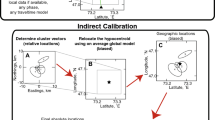Abstract
We propose a machine learning method for mapping potential earthquake source zones (ESZ). We use two hypotheses: (1) the recurrence of strong earthquakes and (2) the dependence of sources of strong earthquakes on the properties of the geological environment. To solve this problem, we know the catalog of earthquakes and a set of spatial fields of geological and geophysical features. We tested the method of identification of the potential ESZ with \(m\ge 6.0\) for the Caucasus region. The map of the potential earthquake source zones and a geological interpretation of the decision rule are presented.
The paper is supported by the Russian Science Foundation, project No20-07-00445.
Access this chapter
Tax calculation will be finalised at checkout
Purchases are for personal use only
Similar content being viewed by others
References
Ananin, I.: European part of the USSR, Ural, West Siberia. In: A New Catalog of Strong Earthquakes in the USSR from Ancient Times to 1975, pp. 465–470 (1975). (in Russian)
Bishop, C.M.: Machine Learning and Pattern Recognition. Information Science and Statistics. Springer, Heidelberg (2006)
Bune, V., Gorshkov, G.: Seismic zonation of USSR, p. 307. Nauka, Moscow (1980)
Burton, P.W.: Seismic risk in southern Europe through to India examined using Gumbel’s third distribution of extreme values. Geophys. J. Int. 59(2), 249–280 (1979)
Fawcett, T.: An introduction to ROC analysis. Pattern Recogn. Lett. 27(8), 861–874 (2006)
Geisser, S.: Predictive Inference, vol. 55. CRC Press, Boca Raton (1993)
Gelfand, I., et al.: Pattern recognition applied to earthquake epicenters in California. Phys. Earth Planet. Inter. 11(3), 227–283 (1976)
Gitis, V., Ermakov, B.: Fundamentals of spatiotemporal forecasting in geoinformatics, p. 256. FIZMATGIS, Moscow (2004)
Gitis, V.G., Derendyaev, A.B.: Machine learning methods for seismic hazards forecast. Geosciences 9(7), 308 (2019)
Gitis, V., Andrienko, G., Andrienko, N.: Exploration of seismological information in analytical web GIS. Izvestiya. Phys. Solid Earth 40(3), 216–225 (2004)
Gitis, V., Ermakov, B., Ivanovskaya, L., Osher, B., Trofimov, D., Shchukin, Y.K.: The GEO expert system: application for seismic hazard analysis of the caucasus region. In: Cahiers du Centre Europeen de Geodynamique et de Seismologie. Centre européen de géodynamique et de séismologie (1992)
Khan, S.S., Madden, M.G.: A survey of recent trends in one class classification. In: Coyle, L., Freyne, J. (eds.) AICS 2009. LNCS (LNAI), vol. 6206, pp. 188–197. Springer, Heidelberg (2010). https://doi.org/10.1007/978-3-642-17080-5_21
Kijko, A.: Estimation of the maximum earthquake magnitude, \(m_{max}\). Pure Appl. Geophys. 161(8), 1655–1681 (2004)
Kondorskaia, N., Shebalin, N.: New Catalog of Strong Earthquakes in the USSR from Ancient Times Through 1977, vol. 31. World Data Center A for Solid Earth Geophysics (1982)
Kotsiantis, S.B., Zaharakis, I., Pintelas, P.: Supervised machine learning: a review of classification techniques. Emerg. Artif. Intell. Appl. Comput. Eng. 160, 3–24 (2007)
Philip, H., Cisternas, A., Gvishiani, A., Gorshkov, A.: The Caucasus: an actual example of the initial stages of continental collision. Tectonophysics 161(1–2), 1–21 (1989)
Pisarenko, V.: Statistical evaluation of maximum possible earthquakes. Phys. Solid Earth 27(9), 757–763 (1991)
Riznichenko, Y.V.: The source dimensions of the crustal earthquakes and the seismic moment. In: Issledovaniya po fizike zemletryasenii, pp. 9–27 (1976)
Sapozhenko, A., Chukhrov, I.: Boolean function minimization in the class of disjunctive normal forms. J. Sov. Math. 46(4), 2021–2052 (1989)
Sibson, R.H.: Frictional constraints on thrust, wrench and normal faults. Nature 249(5457), 542–544 (1974)
Soloviev, A., Novikova, O., Gorshkov, A., Piotrovskaya, E.: Recognition of potential sources of strong earthquakes in the Caucasus region using GIS technologies. Dokl. Earth Sci. 450(2), 658 (2013). https://doi.org/10.1134/S1028334X13060159
Author information
Authors and Affiliations
Corresponding author
Editor information
Editors and Affiliations
Rights and permissions
Copyright information
© 2020 Springer Nature Switzerland AG
About this paper
Cite this paper
Petrov, K.N., Gitis, V.G., Derendyaev, A.B. (2020). A Method of Identification of Potential Earthquake Source Zones. In: Gervasi, O., et al. Computational Science and Its Applications – ICCSA 2020. ICCSA 2020. Lecture Notes in Computer Science(), vol 12252. Springer, Cham. https://doi.org/10.1007/978-3-030-58811-3_29
Download citation
DOI: https://doi.org/10.1007/978-3-030-58811-3_29
Published:
Publisher Name: Springer, Cham
Print ISBN: 978-3-030-58810-6
Online ISBN: 978-3-030-58811-3
eBook Packages: Computer ScienceComputer Science (R0)




